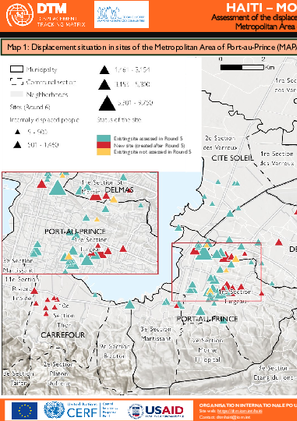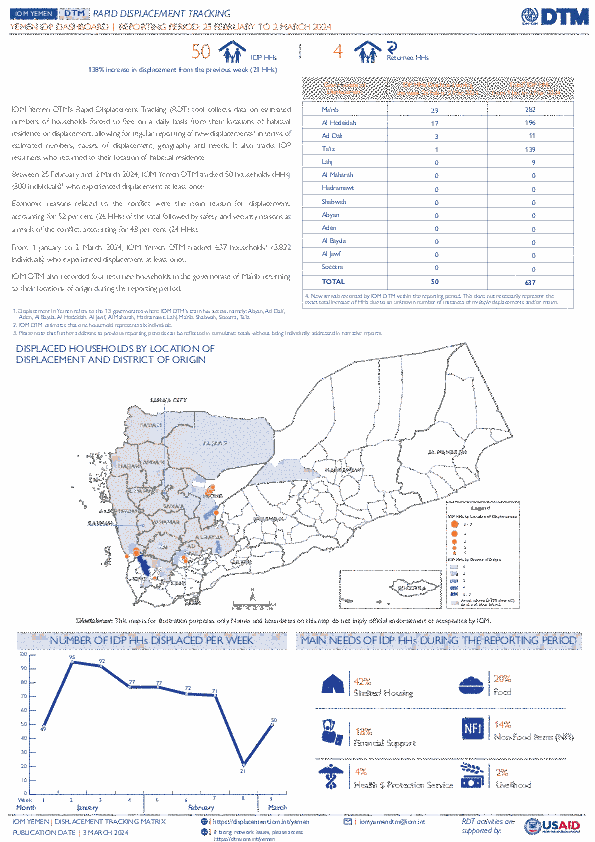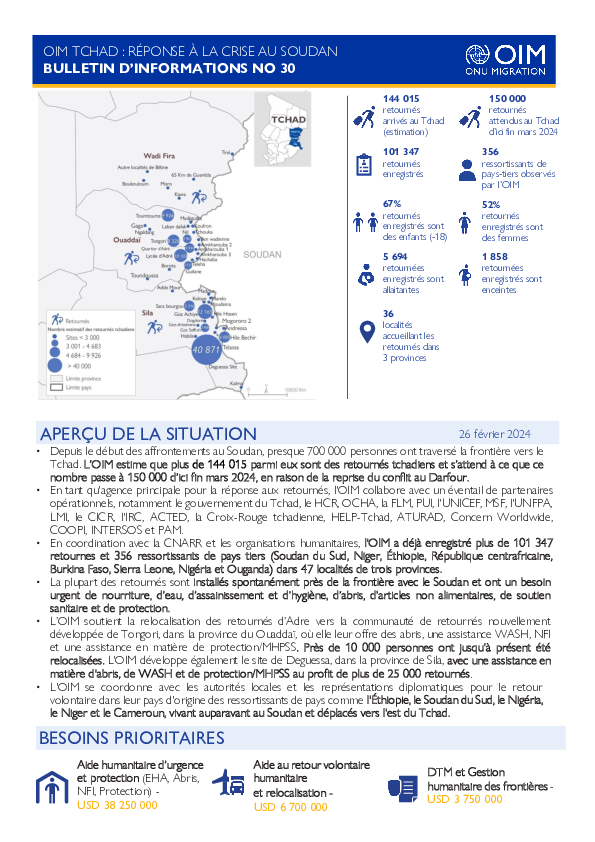-
Countries
-
Data and Analysis
-
Special Focus
-
Crisis Responses
Situation Report

Contact
DTM Haiti, dtmhaiti@iom.int
Language
English
Location
Haiti
Period Covered
Jan 20 2024
Mar 03 2024
Activity
- Mobility Tracking
- Site Assessment
- Baseline Assessment
In the Metropolitan Area of Port-au-Prince, 61% of IDPs reside in spontaneous sites, exposed to several protection, health and other risks. This report presents an overview of the displacement situation in these sites.

Contact
DTM Nigeria, iomnigeriadtm@iom.int
Language
English
Location
Nigeria
Snapshot Date
Mar 02 2024
Activity
- Mobility Tracking
- Event Tracking
On 2 March 2024, a fire broke out in Muna El-Badawy camp in Jere Local Government Area (LGA) of Borno State. The fire damaged and destroyed the shelters and belongings of numerous displaced households. There was a report of one fatality and no injuries reported. The fire impacted 287 emergency shelters, affecting 1,799 individuals in 257 households. The affected individuals included 1,539 children, 131 women and 129 men.
Of all the needs identified, food, shelter and non-food items (NFI) were the most prevalent. Other needs included water, sanitation and hygiene (WASH) and psychosocial support. As a preventive measure against fire outbreaks, most communities need fire-resistant materials for their shelters and detached shelters.

Contact
DTM Nigeria, iomnigeriadtm@iom.int
Language
English
Location
Nigeria
Period Covered
Feb 26 2024
Mar 03 2024
Activity
- Mobility Tracking
- Event Tracking
On 03 March 2024, armed bandits attacked the communities of Kanwa, Kadamasa, Takurawa, Marmaru and Bako Gebe in Zurmi ward of Zurmi LGA in Zamfara State. The attacks damaged and destroyed 35 shelters and the belongings of numerous households in the communities.
There were reports of 21 injuries and no fatalities were reported. The attacks affected 7,093 individuals in 1,012 households. The affected individuals included 3,973 children, 2,038 women and 1,082 men.
Of all the needs identified, food, shelter and non-food items were the most prevalent.

Contact
DTM Nigeria, iomnigeriadtm@iom.int
Language
English
Location
Nigeria
Period Covered
Feb 19 2024
Feb 25 2024
Activity
- Mobility Tracking
- Event Tracking
On 18 February 2024, armed bandits attacked the communities of Doka in Idon ward of Kajuru LGA and Ungwan Fatuka in Gayam ward of Birnin Gwari LGA of Kaduna State. Forty-five shelters and properties of multiple households were damaged or destroyed in the communities as a result of the attacks. There were reports of 11 injuries and 11 fatalities. The attacks affected 4,826 individuals in 929 households. The affected individuals included 2,919 children, 1,070 women and 837 men. On 19 and 25 February 2024, farmer-herder clashes occurred in the communities of Kendev in Mbaikyor ward of Kwande LGA, Ortwav in Ikyaghev ward of Gwer LGA and Tse-Agena in Borikyo ward of Ukum LGA in Benue State. Two hundred and ninety shelters and properties of multiple households were damaged or destroyed in the communities as a result of the attacks. There were reports of 26 injuries and four fatalities. The attacks affected 1,747 individuals in 290 households. The affected individuals included 713 children, 565 women and 469 men.

Contact
DTMMozambique@iom.int
Language
English
Location
Mozambique
Period Covered
Feb 08 2024
Mar 03 2024
Activity
- Mobility Tracking
- Event Tracking
Between 22 December 2023 to 03 March 2024, sporadic attacks and fear of attacks by Non-state Armed Groups in Ibo, Macomia, Chiure, Mecufi, Mocimboa da Praia, and Muidumbe triggered the cumulative displacement 112,894 individuals/24,241 families. [For more see Emergency Tracking Online Dashboard]. The current Movement Alert #103 reports on recent attacks recorded in Chiure, Macomia, and Mecufi between 08 February to 03 March that displaced 99,313 individuals.

Contact
DTM Yemen, iomyemendtm@iom.int
Language
English
Location
Yemen
Period Covered
Feb 25 2024
Mar 02 2024
Activity
- Mobility Tracking
- Event Tracking
IOM Yemen DTM’s Rapid Displacement Tracking (RDT) tool collects data on estimated numbers of households forced to flee on a daily basis from their locations of origin or displacement, allowing for regular reporting of new displacements in terms of estimated numbers, geography, and needs. It also tracks returnees who returned to their location of origin.
From 1 January to 2 March 2024, IOM Yemen DTM tracked 637 households (HH) (3,822 Individuals) who experienced displacement at least once.
Between 25 February and 2 March 2024, IOM Yemen DTM tracked 50 households (300 individuals) displaced at least once. The majority of people moved into/within the following governorates and districts:
- Ma’rib (29 HHs) – Ma’rib City (19 HHs), Ma’rib (7 HHs), Harib (3 HHs) districts. Most displacements in the governorate originated from Ma’rib and Sanaa.
- Al Hodeidah (17 HHs) – Hays (15 HHs), Al Khukhah (2 HHs) districts. Most displacements in the governorate originated from Al Hodeidah and Ta’iz.
- Ad Dali (3 HHs) – Ad Dali (3 HHs) district. All displacements in the governorate were internal.
The majority of people moved from the following governorates and districts:
- Al Hodeidah (13 HHs) – Hays (7 HHs), Al Jarrahi (2 HHs), Al Mina (1 HH) districts.
- Ta’iz (9 HHs) – Maqbanah (6 HHs), At Taiziyah (1 HH), Al Waziyah (1 HH) districts.
- Ma’rib (7 HHs) – Harib (3 HHs), Raghwan (2 HHs), Al Jubah (1 HH) districts.
IOM identified 35 households displaced in the previous reporting period, which covered 18 - 24 February 2024, in the governorates of Al Hodeidah (26 HHs), Ma’rib (8 HHs), Ta’iz (1 HH). These figures have been added to the cumulative displacement total recorded since the beginning of the year.

Contact
DTMMozambique@iom.int
Language
English
Location
Mozambique
Period Covered
Feb 08 2024
Feb 27 2024
Activity
- Mobility Tracking
- Event Tracking
Between 22 December 2023 to 27 February 2024, sporadic attacks and fear of attacks by Non-state Armed Groups in Macomia, Chiure, Mecufi, Mocimboa da Praia, and Muidumbe triggered the cumulative displacement 81,721 individuals/17,591 families. [For more see Emergency Tracking Online Dashboard]. The current Movement Alert #102 reports on recent attacks recorded in Chiure, Macomia, and Mecufi between 8 to 27 February that displaced 68,156 individuals.

Contact
DTM Chad, dtmtchad@iom.int
Language
French
Location
Chad
Period Covered
Feb 15 2024
Feb 24 2024
Activity
- Mobility Tracking
- Event Tracking
• Depuis le début des affrontements au Soudan, presque 700 000 personnes ont traversé la frontière vers le Tchad. L’OIM estime que plus de 144 015 parmi eux sont des retournés tchadiens et s’attend à ce que ce nombre passe à 150 000 d’ici fin mars 2024, en raison de la reprise du conflit au Darfour.
• En tant qu'agence principale pour la réponse aux retournés, l'OIM collabore avec un éventail de partenaires opérationnels, notamment le gouvernement du Tchad, le HCR, OCHA, la FLM, PUI, l'UNICEF, MSF, l'UNFPA, LMI, le CICR, l'IRC, ACTED, la Croix-Rouge tchadienne, HELP-Tchad, ATURAD, Concern Worldwide, COOPI, INTERSOS et PAM.
• En coordination avec la CNARR et les organisations humanitaires, l'OIM a déjà enregistré plus de 101 347 retournes et 356 ressortissants de pays tiers (Soudan du Sud, Niger, Éthiopie, République centrafricaine, Burkina Faso, Sierra Leone, Nigéria et Ouganda) dans 47 localités de trois provinces.
• La plupart des retournés sont installés spontanément près de la frontière avec le Soudan et ont un besoin urgent de nourriture, d’eau, d’assainissement et d’hygiène, d’abris, d’articles non alimentaires, de soutien sanitaire et de protection.
• L’OIM soutient la relocalisation des retournés d’Adre vers la communauté de retournés nouvellement développée de Tongori, dans la province du Ouaddaï, où elle leur offre des abris, une assistance WASH, NFI et une assistance en matière de protection/MHPSS. Près de 10 000 personnes ont jusqu’à présent été relocalisées. L'OIM développe également le site de Deguessa, dans la province de Sila, avec une assistance en matière d'abris, de WASH et de protection/MHPSS au profit de plus de 25 000 retournés.
• L'OIM se coordonne avec les autorités locales et les représentations diplomatiques pour le retour volontaire dans leur pays d'origine des ressortissants de pays comme l'Éthiopie, le Soudan du Sud, le Nigéria, le Niger et le Cameroun, vivant auparavant au Soudan et déplacés vers l'est du Tchad.

Contact
DTM Chad, dtmtchad@iom.int
Language
English
Location
Chad
Period Covered
Feb 15 2024
Feb 24 2024
Activity
- Mobility Tracking
- Event Tracking
• Nearly 700,000 people have crossed into Chad since the onset of the crisis in Sudan. IOM estimates that more than 144,015 among them are Chadian returnees and expects this number to rise to 150,000 by the end of March 2024, due to ongoing conflict in Darfur.
• IOM, as the lead agency for the returnee response, collaborates with a range of operational partners including the Government of Chad, UNHCR, OCHA, LWF, PUI, UNICEF, MSF, UNFPA, LMI, ICRC, IRC, ACTED, the Chadian Red Cross, HELP-Tchad, ATURAD, Concern Worldwide, COOPI, INTERSOS, and WFP.
• In coordination with CNARR and humanitarian organizations, IOM has registered 101,347 returnees and identified 356 third-country nationals (from South Sudan, Niger, Ethiopia, the Central African Republic, Burkina Faso, Sierra Leone, Nigeria, and Uganda) in 47 localities in three provinces.
• Most of the returnees currently live in spontaneous locations near the border and are in urgent need of food, water, sanitation and hygiene, shelter, household items, health, and protection.
• IOM is relocating returnees from Adre to the newly developed returnee community of Tongori, Ouaddaï province, where it offers them shelters, WASH, NFI, and Protection/MHPSS assistance. Over 11,000 individuals have so far been relocated. IOM is also developing the site of Deguessa, Sila province, with shelter, WASH, and Protection/MHPSS assistance for the benefit of over 25,000 returnees.
• IOM is coordinating with local authorities and diplomatic representations for the voluntary return to their home countries of third-country nationals (TCNs) from countries including Ethiopia, South Sudan, Nigeria, Niger, and Cameroon previously living in Sudan and displaced to eastern Chad.

Contact
Niger Migration Data and Research Unit - nigerdataresearch@iom.int
Language
French
Location
Niger
Period Covered
Dec 01 2023
Dec 31 2023
Activity
- Survey
- Displacement Solutions
- Mobility Tracking
La région de Diffa, située dans le bassin du lac Tchad, fait face à une crise humanitaire grave en raison du conflit en cours et des attaques de groupes armés non étatique (GANE) non étatique. Cette situation a provoqué d'importants déplacements de populations et une détérioration des conditions de vie. Les déplacés internes, les réfugiés et les communautés d'accueil sont confrontés à des défis majeurs tels que l'accès restreint à l'eau potable, à la nourriture, aux soins de santé et à l'éducation. Les organisations humanitaires s'efforcent activement de répondre à ces besoins urgents en fournissant une aide vitale, en soutenant les infrastructures locales et en protégeant les droits des personnes touchées. Cependant, la situation demeure préoccupante et nécessite une attention continue ainsi que des ressources supplémentaires pour atténuer les souffrances et trouver des solutions durables.
Afin de trouver des solutions durables aux déplacements internes et de prévenir de nouveaux déplacements dans la région, il est crucial de comprendre les niveaux de stabilité dans les zones accueillant les populations déplacées. L'Organisation internationale pour les migrations (OIM) a introduit l’indice de solution et de mobilité (ISM) en 2019 pour évaluer la stabilité des zones accueillant les rapatriés ou les populations déplacées dans le bassin du lac Tchad (BLC). Cet indice vise à identifier les facteurs qui influent sur la stabilité d'un lieu afin de déterminer les interventions prioritaires pour la transition et le rétablissement, renforçant ainsi la résilience et la stabilité dans une région marquée par les conflits et les déplacements. L’ISM mesure les perceptions de stabilité et analyse les facteurs influençant les décisions des populations de rester ou de se déplacer. Il fournit un outil permettant aux autorités et aux partenaires de développer des stratégies plus efficaces, de prioriser les ressources et de planifier les interventions dans les zones fragiles et instables, en intégrant des approches humanitaires, de relèvement et de stabilisation. Ce rapport présente les résultats du cinquième cycle de collecte de données de l’ISM, réalisé entre le 18 novembre et le 8 décembre 2023 dans la région de Diffa, au Niger.
Pagination
- Previous page
- Page 15
- Next page